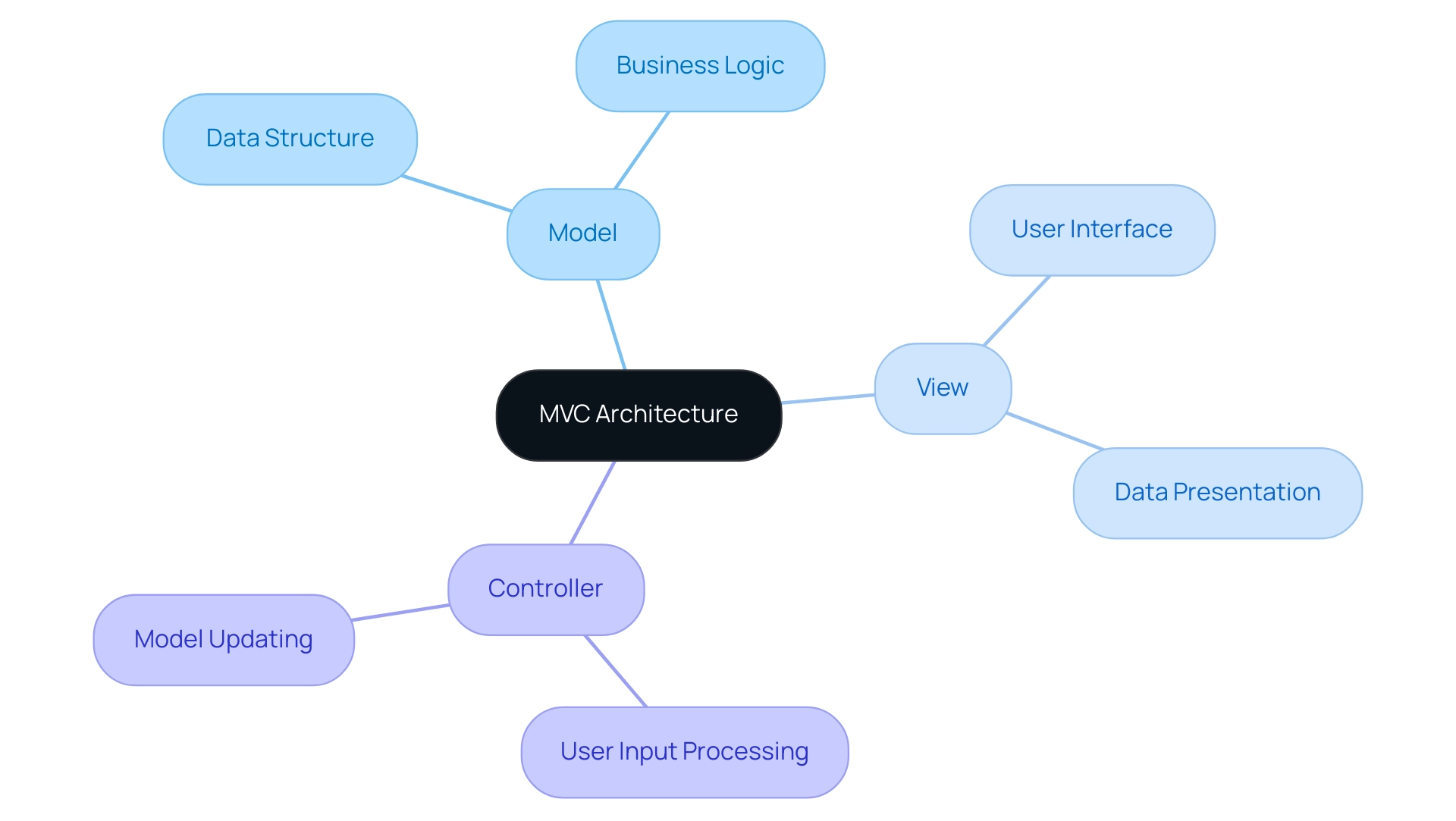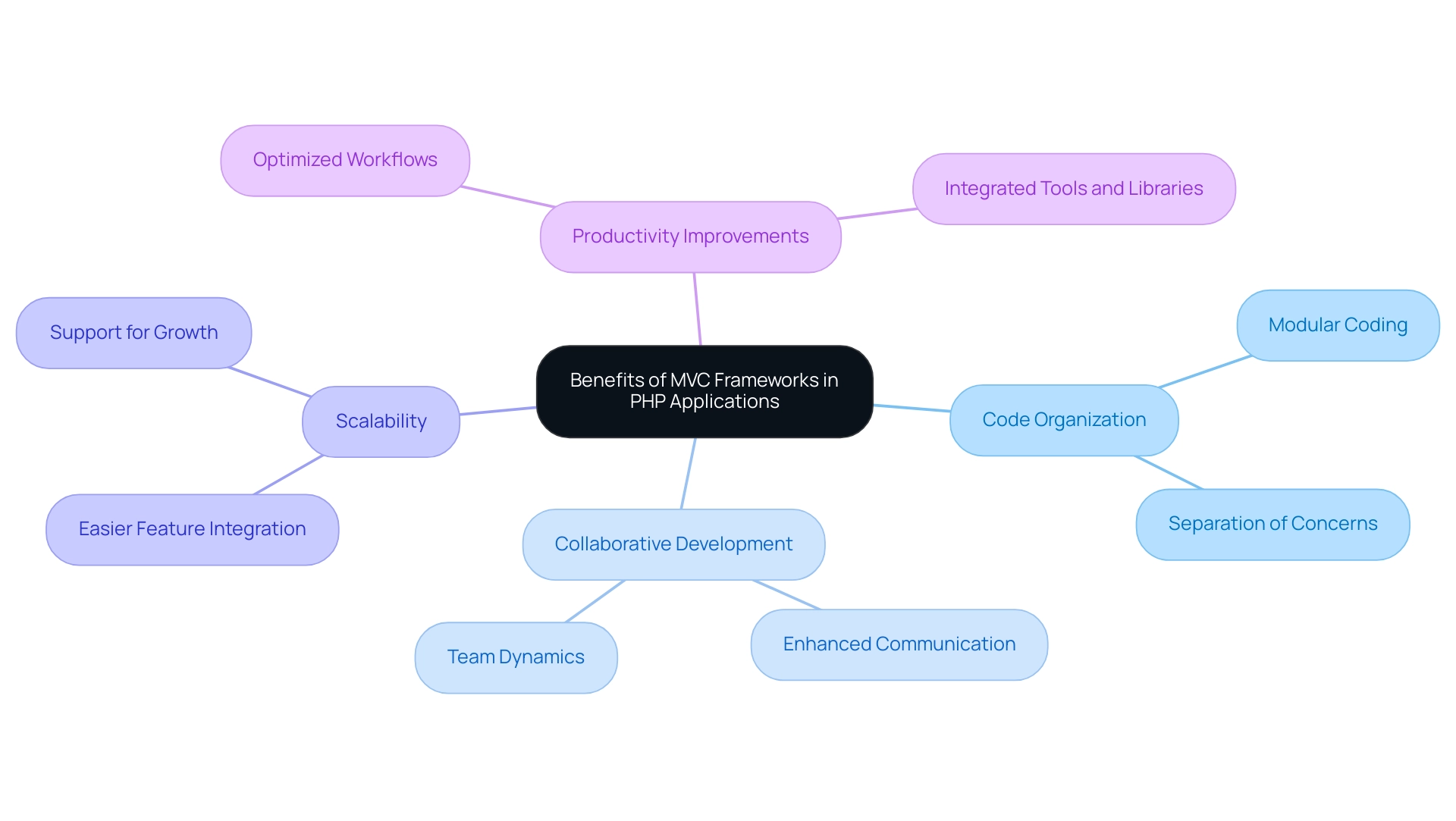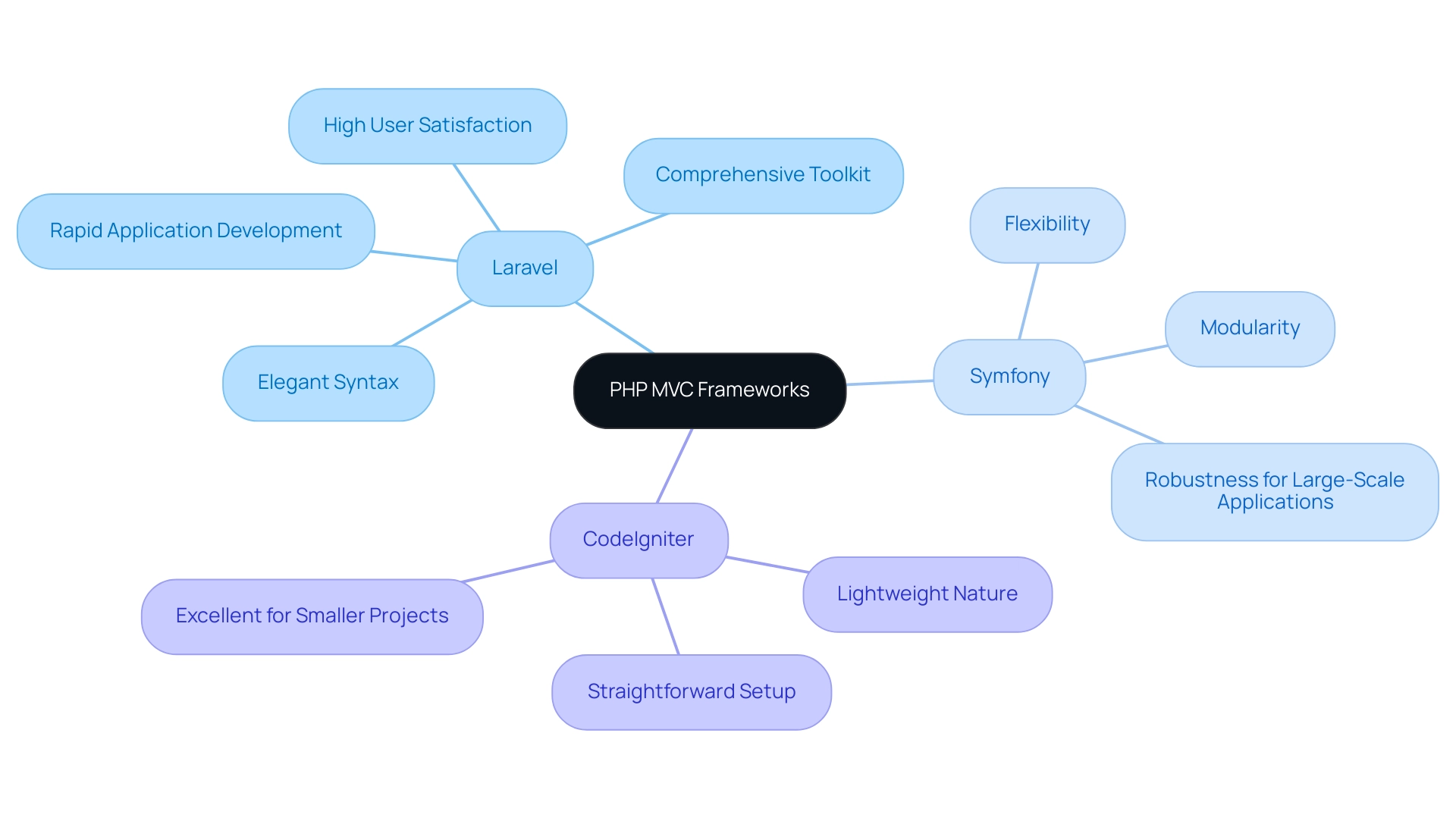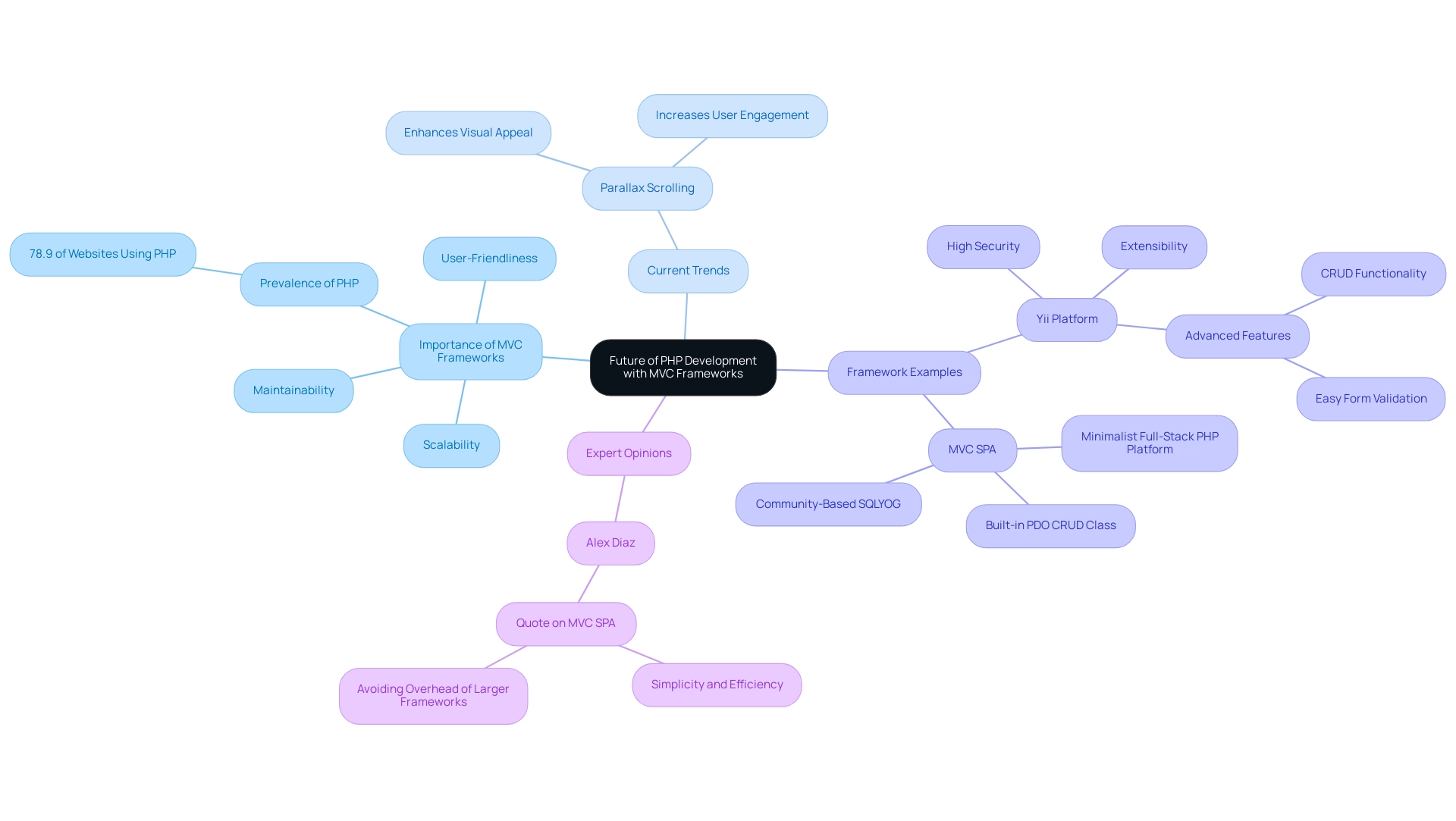Introduction
In the realm of PHP development, the Model-View-Controller (MVC) architecture stands as a cornerstone for creating structured and efficient applications. By delineating responsibilities among the Model, View, and Controller, this architectural pattern not only enhances code organization but also empowers developers to build scalable and maintainable solutions.
As the landscape of web development shifts towards more modular approaches, the adoption of MVC frameworks like Laravel and Symfony is on the rise, driven by their ability to streamline workflows and foster collaboration.
With insights from industry trends and expert opinions, this article delves into the intricacies of MVC architecture, its benefits, and the popular frameworks that are shaping the future of PHP development, providing developers with the knowledge needed to thrive in an ever-evolving digital environment.
Understanding the MVC Architecture: A Foundation for PHP Development
Model-View-Controller (MVC) serves as a fundamental software architectural pattern that divides an application into three essential components: the Model, the View, and the Controller. This strategic separation enhances code organization, allowing programmers to manage and scale applications with greater efficiency. The Model encapsulates the data structure and business logic, while the View is tasked with rendering the user interface and presenting data to users.
The Controller acts as an intermediary, facilitating communication between the Model and the View by processing user inputs and updating the Model accordingly. By adopting MVC frameworks for building PHP web applications, programmers are empowered to create more modular applications, significantly enhancing maintainability and flexibility in PHP web development. Recent statistics indicate a notable increase in the adoption of MVC architecture, with projections for 2024 showing a continued upward trend.
This shift reflects a broader trend in the development community towards more structured and efficient coding practices, underscoring the ongoing evolution of PHP systems. Significantly, studies suggest that Laravel surpasses other PHP systems regarding efficiency and quality, making it a favored option for numerous programmers. As emphasized in the case study 'Navigating the PHP Landscape,' the diverse range of PHP structures available today allows developers to choose those that best align with their expertise and specific project needs, ensuring a tailored approach to software development.
Aijaz Mughal, a reliable consultant in Digital Marketing and Business Growth, highlights that the effective application of such structures is essential for attaining digital marketing success, further endorsing the significance of MVC architecture in contemporary web development.

Benefits of Using MVC Frameworks in PHP Applications
The use of MVC frameworks for building PHP web applications presents a multitude of advantages that significantly enhance code organization and facilitate collaborative development. By structuring applications into distinct components—Model, View, and Controller—developers can work on different segments concurrently without risking conflicts. This modular approach not only allows for greater scalability but also enables the seamless integration of new features, minimizing disruptions to existing codebases.
Statistically, as we approach 2024, a notable shift in productivity among programmers is observed, with:
- 24% of Integrated Development Platform (IDP) users citing time to find context as a primary impediment
- 48% of non-IDP users reporting the same issue
This emphasizes the effectiveness of MVC structures in optimizing workflows. For example, programmers employing platforms such as Laravel and Symfony gain from integrated tools and libraries that simplify development processes, ultimately enhancing speed and efficiency.
Moreover, the separation of concerns inherent in MVC structures fosters better collaboration among team members. Each programmer can concentrate on their area of expertise, leading to clearer communication and a more cohesive team dynamic. As Amber, a Software Engineering Manager, noted, "Monitoring software productivity relies heavily on effective collaboration methods, which MVC structures inherently support."
This structured environment not only enhances individual contributions but also drives collective project success.
The adoption of MVC frameworks for building PHP web applications not only enhances code organization but also aligns with modern development practices, making it a vital consideration for any PHP application aiming for longevity and maintainability. Moreover, the case study of the React system demonstrates how its component-oriented structure aids in recruiting talented programmers and encourages teamwork, further strengthening the advantages of modular coding practices.

Exploring Popular PHP MVC Frameworks: Laravel, Symfony, and More
The PHP development ecosystem includes several MVC frameworks for building PHP web applications that have garnered considerable attention for their unique characteristics and abilities. Laravel stands out with its elegant syntax and comprehensive toolkit, making it particularly suitable for rapid application development. According to a recent survey of 48,503 respondents, Laravel boasts one of the highest user satisfaction ratings in the community, attributed to its intuitive design and extensive documentation.
Symfony, on the other hand, is renowned for its flexibility and modularity, enabling programmers to incorporate only the components essential for their projects. This adaptability is echoed in the opinions of PHP experts who often highlight Symfony’s robustness in large-scale applications. Another contender is CodeIgniter, favored for its lightweight nature and straightforward setup, making it an excellent choice for smaller projects.
Each of these MVC frameworks for building PHP web applications not only caters to different project needs but also aligns with current trends in the industry. As programmers explore their options, understanding the latest features of Laravel and Symfony—such as improved performance and enhanced security measures—will be crucial in selecting the architecture that best suits their project requirements. Additionally, with 41% of Chat GPT users expressing interest in utilizing GitHub Copilot next year, it is evident that developers are increasingly looking for tools that enhance their coding efficiency.
Moreover, akin to WordPress, which holds over 62.8% market share among recognized CMS users, the adoption of PHP structures is also increasing, indicating a dynamic market landscape.

Conclusion: The Future of PHP Development with MVC Frameworks
As the digital landscape evolves, MVC frameworks for building PHP web applications are set to significantly influence the future of PHP web development. With roughly 78.9% of websites utilizing PHP server-side programming, the adoption of MVC frameworks for building PHP web applications is becoming increasingly vital for programmers. These MVC frameworks for building PHP web applications enable the development of scalable, maintainable, and user-friendly applications, allowing creators to effectively address the needs of contemporary users.
Notably, trends such as parallax scrolling are enhancing visual appeal and user engagement, further underscoring the need for modern techniques in web development. The case study titled 'Navigating the PHP Environment Landscape' reflects on the diverse options available in PHP structures, encouraging developers to choose systems that align with their expertise and project requirements. Emerging technologies are influencing these structures, enhancing their capabilities and performance.
For instance, the Yii platform stands out due to its high security, extensibility, and advanced features such as CRUD functionality and easy form validation. Alex Diaz, founder of Fair Designs LLC, emphasizes the need for simplicity and efficiency, noting,
"You could use the MVC spa instead which is a minimalist full-stack PHP platform without all the overhead of Laravel | CodeIgniter & their performance issues."
This perspective highlights the trend towards lighter, more adaptable solutions that meet the needs of programmers.
As the MVC landscape continues to evolve, staying informed about the latest advancements in MVC frameworks for building PHP web applications will empower developers to fully leverage these frameworks, fostering innovation and ensuring success in their web development projects.

Conclusion
The Model-View-Controller (MVC) architecture is essential for the advancement of PHP development, providing a structured approach that enhances code organization and fosters collaboration among developers. By clearly defining the roles of the Model, View, and Controller, MVC frameworks like Laravel and Symfony enable the creation of scalable and maintainable applications that align with modern coding practices.
The benefits of MVC frameworks extend beyond organization; they allow developers to work on different components simultaneously, streamlining workflows and boosting productivity. This modularity is increasingly vital as the demand for efficient coding solutions rises, making the integration of new features seamless and effective.
As the PHP development landscape continues to evolve, understanding the unique strengths of popular frameworks like Laravel’s elegant syntax and Symfony’s flexibility is crucial for developers. These insights allow for informed decisions that align with specific project needs.
In summary, adopting MVC architecture is a strategic choice that empowers developers to create sophisticated, user-friendly applications. By staying updated on the latest advancements and selecting frameworks that best fit their expertise, developers can navigate the competitive digital landscape successfully. The future of PHP development is bright, and those knowledgeable in MVC frameworks will be well-equipped to drive innovation and achieve project success.





